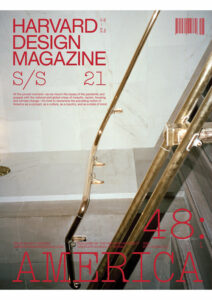“America: I’ve Given You All and Now I’m Nothing”
Ann,
I’m writing to you from the edge of America to its center, from the coast to the heartland, from fire to lake effect, from a city catching headlines for homelessness and immigration (Los Angeles) to a city skewed by inequity and neighborhood shootings (Chicago).
We’ve been asked to exchange thoughts on American Architecture, those two As echoing importance and stability off each other’s letterforms in a kind of indulgent feedback loop. And once again, we are both asked to represent American Architecture; but who are we and what is it?
We are both Californians, women, and children and grandchildren of migrants. Must our reflections be as robust and privileged as the edifice of our nation demands? I just filed an essay on Ezra Stoller, a photographer who shed his skin as a first-generation Jew in order to become the 20th century’s premier chronicler of American Architecture—glassy towers and campuses for corporate giants designed by émigrés. We are not Ezra Stollers.
Can we discuss architectures—lower case and plural—that are continental, not national? That carry geographic and climate specificities without entering the discursive trap of regionalism? That buck the biases of universalist impulses? Or, in doing so, are we accepting a token—something smaller, less important
Eagerly awaiting your reply,
–Mimi
December 10, 2019
Hi Mimi,
I also wonder about this. How do we talk about the small things without being seen as small? How do we make big claims about capital-A “Architecture” or “America” without being strident— my own worst impulse and a turnoff for both of us?
Apparently, when my parents got married, my mom’s friends teased her that she had landed herself a 金山阿伯—gold mountain old man—an American husband who you marry for immigration status.
When I think of “America,” this whole “gold mountain” thing comes to mind. The Chinese Exclusion Act and the paper sons, including in my family, who eluded the discriminatory law through fraudulent paperwork. The shining topography defined by the space between subterfuge and longing. Also: the relative ease of our assimilation against the backdrop of everything else. In the words of Pedro Neves Marques: “One community’s clean water is another’s polluted stream.” From Turtle Island to America. From “gold mountain” to Trump’s golden toilet and so on.
For me, this dialectic of the “gold mountain” overlays everything from the highway interchanges of LA to the grid of Chicago, and architectural practice in these places too. On a bad day, it can feel impossible to move beyond. That one step might cause me to fall off the knife’s edge between feeling like anything is possible and everything is just permanently fucked. But there are slips. “Rival geographies” in authoritarian cartographies. Lately I’ve learned that in mainland China, algorithmic deformations skew geospatial data from Western coordinates, sometimes leaving you 100 meters from where you thought you were—maybe, even, on the other side of a border or fast river.
It’s in these slips that I’m finding stuff. I’m feeling drawn to what doesn’t make sense: magic, meaninglessness, things which elude their makers’ intentions, moments between people which suddenly allow you to feel like you’re someone else. I think that’s the stuff that ultimately has the opportunity to be both little and also transformationally big. Looking now for the architecture in that.
Still refusing to play “Team America,”
Ann
Dear Ann,
Can I claim “Team California”? On rainy days, like today, eucalyptus trees give off a pungent musk and its sharpness smells like home. Imported from Australia for their quick growth, they make for lousy lumber.
I think of the smallness and largeness of rain. Each drop is tiny, but a storm is an immense, collective action. John McPhee writes about how during heavy winter storms, the San Gabriels—the mountains near my house—threaten to unleash themselves, pouring debris fields down the hills and into the suburban homes below. He describes the infrastructure of debris basins—large concrete locks and bowls—ready to catch the spill and thus protect what is below. If a mountain (only gold during the heat of summer) comes loose, these basins fill with liquified earth and boulders, entangled oaks, manzanita, and eucalyptus.
Buildings always seem like such a problematic, medium scale in which to discuss questions of identity or nationhood. Each one is somehow insufficient and self-contained. But infrastructure like the debris basins are American in their bigness and yet sufficiently transformative to suggest both new landscapes and architectures. Mud and concrete.
–M
